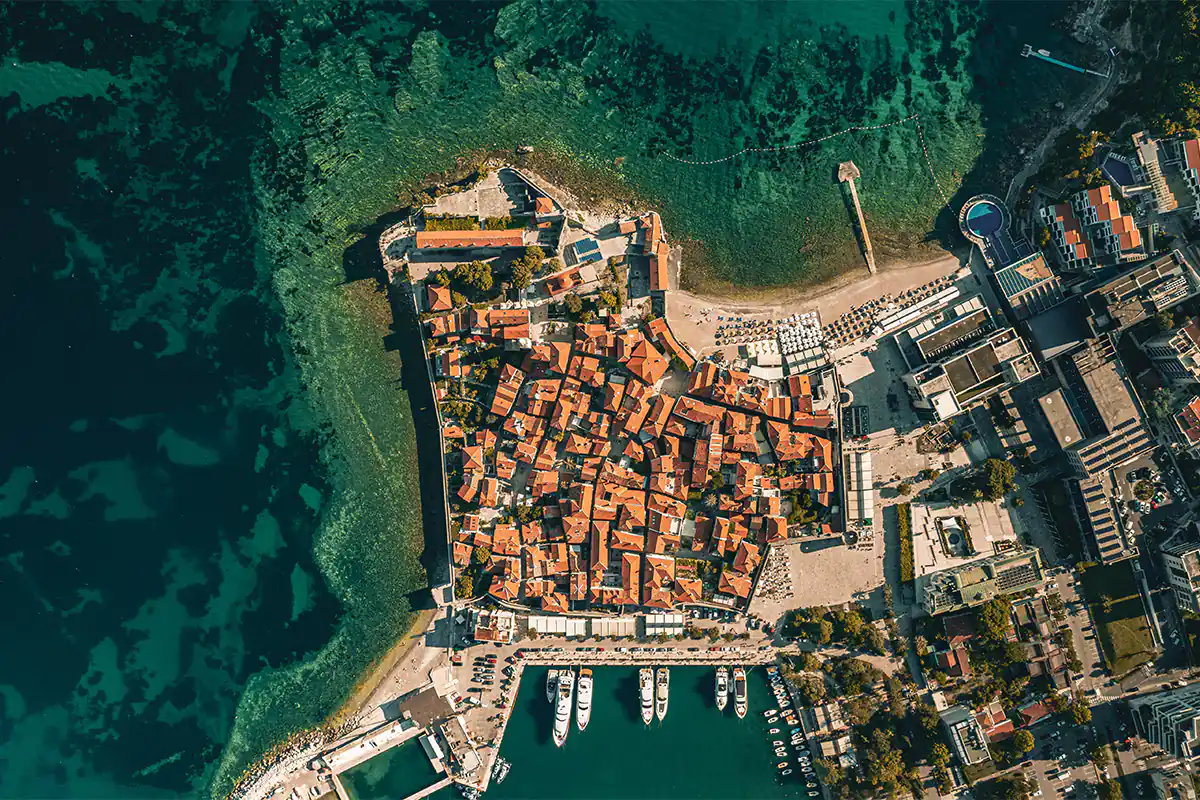
Key Takeaways
- Budva offers a perfect blend of history, culture, and coastal beauty that captivates every traveler.
- Its proximity to Albania makes it an accessible and enriching addition to your Balkan itinerary.
- Explore ancient city walls, stunning beaches, and vibrant nightlife, all infused with a rich Adriatic charm.
- Understanding its shared history with Albania enhances appreciation for the region’s diverse cultural tapestry.
- Practical travel tips ensure a seamless journey from Albania to this charming coastal town.
Imagine wandering through centuries-old streets, feeling the Mediterranean breeze, and witnessing a vibrant culture that has intertwined with neighboring Albania for centuries.
Budva stands as a shining example of this rich interplay of history and natural beauty. Located just about
100 kilometers from Albania, this coastal town offers travelers an unforgettable experience.
Budva – A Coastal Gem for Adriatic Explorers
Budva’s vibrant energy radiates from its lively beaches, historic old town, and bustling nightlife. Its sparkling coastline includes renowned beaches like Mogren, Jaz, and Becici, which beckon visitors to relax or indulge in water sports. *Nature lovers* can also explore scenic coastal trails and lush hills that offer breathtaking vistas of the Adriatic Sea.
Some of the city’s standout landmarks include the picturesque Old Town (Stari Grad), the impressive Citadel fortress providing sweeping sea views, and iconic statues like the Dancing Girl. The nearby Sveti Stefan island resort, with its exclusivity and legendary charm, is a must-see for visitors seeking a taste of luxury and history.
Adding a layer of cultural contrast, visitors from Albania will find engaging activities, such as boat trips, hikes in verdant countryside, or exploring rustic monasteries. Budva’s vibrant nightlife and traditional Montenegrin music bring a lively atmosphere—making it a truly multifaceted destination.
Geographic and Cultural Context: Budva’s Adriatic Embrace
Situated along the Montenegrin coast, Budva’s location places it at the heart of the Adriatic region, sharing centuries of cultural influences with nearby Albania. It is easily accessible via scenic drives or short bus rides from Albanian cities like Saranda and Vlore.
The city’s cultural tapestry bears marks of Venetian, Ottoman, and Slavic influences. These shared heritages are visible in the architecture, cuisine, and local traditions that both regions hold dear. This interconnected history provides travelers with a deeper understanding of the broader Adriatic narrative, enriching their exploration of both Albania and Montenegro.
History and Heritage of Budva: Echoes of Ancient Civilizations
The history of Budva dates back to Illyrian times, evolving through Roman, Byzantine, and Venetian periods. Its old city, fortified walls, and ancient churches serve as living reminders of this layered past. Notable sites include the formidable Citadel and charming churches like St. John the Baptist and Holy Trinity, each telling stories of religious and cultural evolution.
Budva’s enduring legacy closely mirrors the shared history with Albania, with both regions influenced by Illyrian roots, Roman rule, and Byzantinian traditions. Exploring the city grants insight into the broader Mediterranean historical landscape, revealing how empires and cultures shaped this region over centuries.
Attractions and Things to Do in Budva: Coastal Delights and Cultural Encounters
From lounging on renowned beaches like Mogren and Becici to exploring the old town’s charming streets, Budva offers a variety of experiences. Water sports, boat trips, and hikes in picturesque surroundings appeal to adventure seekers and nature lovers alike.
Unique landmarks include the fortress citadel, Sveti Stefan island, and cultural sites such as local monasteries or the lively promenade packed with cafes, shops, and nightlife spots. For those coming from Albania, the cultural contrasts and activities—like exploring traditional Montenegrin cuisine or enjoying vibrant nightlife—make each visit special.
Travel Tips for Visitors from Albania: Bridging the Adriatic
Travel between Albania and Budva is straightforward, with bus routes, car rentals, and organized tours. It’s recommended to check visa requirements, though many visitors—especially from the EU and US—face no hurdles. The best travel period is during May-June or September-October when the weather is mild, and crowds are smaller.
Accommodations range from budget hostels to luxury hotels. Savor fresh seafood and Mediterranean dishes that highlight local flavors. Remember to observe local customs and etiquette, which are generally relaxed but appreciated when respected.
Budva as Part of a Wider Adriatic Travel Experience: A Regional Adventure
Budva’s strategic location makes it perfect for a broader regional itinerary. Drive along the coast from Albanian cities like Saranda or Vlorë for spectacular views, and include attractions like Dubrovnik or Lake Skadar for diverse experiences. Day trips to towns like Kotor or Sveti Stefan can deepen your understanding of the region’s history and culture.
This interconnected region offers travelers an authentic, immersive experience—connecting cultures, histories, and stunning landscapes—beyond traditional travel routes.
Conclusion: Budva – An Adriatic Must-See for Albania Explorers
For those exploring Albania’s vibrant coastal cities, adding
Budva to your itinerary promises a rich blend of history, culture, and coastal beauty. Its proximity and shared heritage make it a convenient and compelling destination that will deepen your understanding of the Adriatic region.
This coastal gem offers an authentic Montenegrin experience, vibrant from its lively streets to its scenic beaches. By visiting Budva, you broaden your journey’s narrative and uncover the diverse stories that make this part of the world truly special. Dive into this adventure, share your experiences, and let this stunning city leave a lasting impression on your travels.





